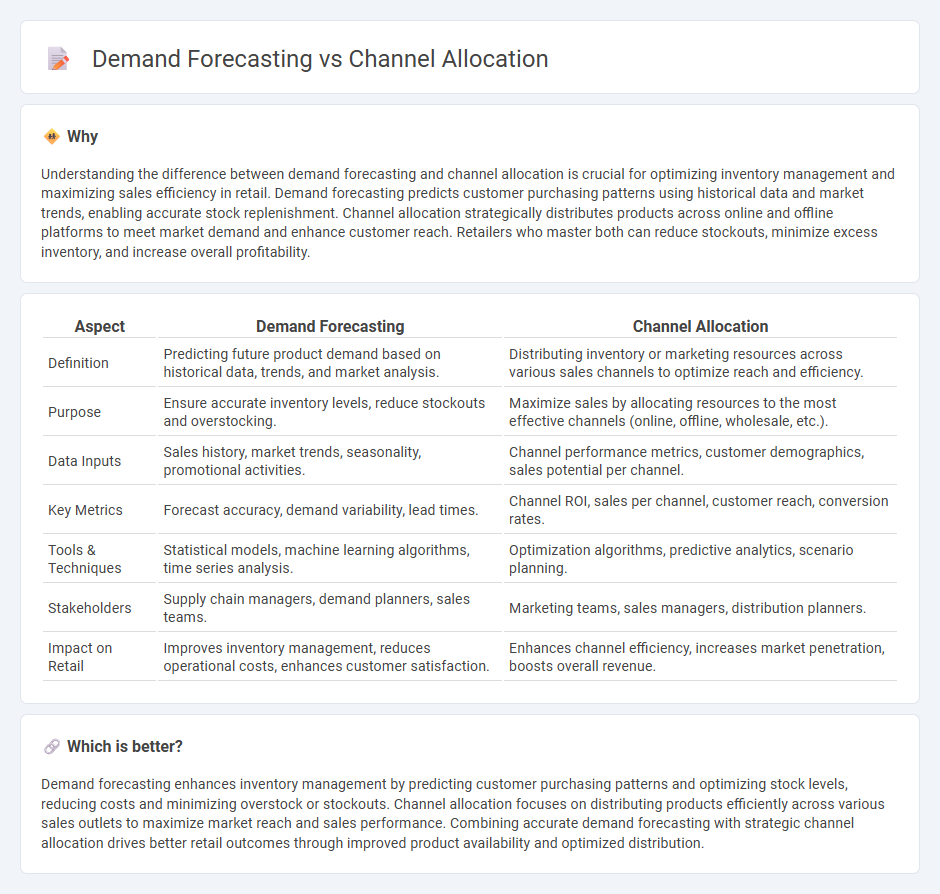
Demand forecasting uses historical sales data and market trends to predict future customer demand accurately. Channel allocation optimizes inventory distribution across various sales channels to maximize revenue and reduce stockouts. Explore how integrating demand forecasting with channel allocation enhances retail efficiency and profitability.
Why it is important
Understanding the difference between demand forecasting and channel allocation is crucial for optimizing inventory management and maximizing sales efficiency in retail. Demand forecasting predicts customer purchasing patterns using historical data and market trends, enabling accurate stock replenishment. Channel allocation strategically distributes products across online and offline platforms to meet market demand and enhance customer reach. Retailers who master both can reduce stockouts, minimize excess inventory, and increase overall profitability.
Comparison Table
| Aspect | Demand Forecasting | Channel Allocation |
|---|---|---|
| Definition | Predicting future product demand based on historical data, trends, and market analysis. | Distributing inventory or marketing resources across various sales channels to optimize reach and efficiency. |
| Purpose | Ensure accurate inventory levels, reduce stockouts and overstocking. | Maximize sales by allocating resources to the most effective channels (online, offline, wholesale, etc.). |
| Data Inputs | Sales history, market trends, seasonality, promotional activities. | Channel performance metrics, customer demographics, sales potential per channel. |
| Key Metrics | Forecast accuracy, demand variability, lead times. | Channel ROI, sales per channel, customer reach, conversion rates. |
| Tools & Techniques | Statistical models, machine learning algorithms, time series analysis. | Optimization algorithms, predictive analytics, scenario planning. |
| Stakeholders | Supply chain managers, demand planners, sales teams. | Marketing teams, sales managers, distribution planners. |
| Impact on Retail | Improves inventory management, reduces operational costs, enhances customer satisfaction. | Enhances channel efficiency, increases market penetration, boosts overall revenue. |
Which is better?
Demand forecasting enhances inventory management by predicting customer purchasing patterns and optimizing stock levels, reducing costs and minimizing overstock or stockouts. Channel allocation focuses on distributing products efficiently across various sales outlets to maximize market reach and sales performance. Combining accurate demand forecasting with strategic channel allocation drives better retail outcomes through improved product availability and optimized distribution.
Connection
Demand forecasting predicts future customer purchases using historical sales data and market trends, enabling retailers to allocate inventory efficiently across various sales channels. Accurate forecasting ensures optimal channel allocation by balancing stock levels in physical stores, online platforms, and distribution centers, reducing overstock and stockouts. Integrating demand forecasting with channel allocation improves supply chain responsiveness and boosts customer satisfaction through timely product availability.
Key Terms
Distribution Channels
Channel allocation optimizes the distribution of products across multiple sales outlets, ensuring maximum market coverage and efficient inventory management. Demand forecasting predicts consumer purchasing patterns to align supply with expected demand, reducing stockouts and excess inventory in distribution channels. Explore how integrating channel allocation with demand forecasting enhances distribution efficiency and customer satisfaction.
Inventory Planning
Channel allocation optimizes product distribution across multiple sales channels to prevent stockouts and overstock situations, directly impacting inventory turnover rates. Demand forecasting uses historical sales data, market trends, and seasonality to predict future product demand, enabling precise inventory replenishment and reduced holding costs. Explore detailed strategies to integrate channel allocation with demand forecasting for superior inventory planning efficiency.
Sales Prediction
Channel allocation optimizes the distribution of products across various sales channels to maximize market coverage and revenue generation. Demand forecasting predicts future sales volumes by analyzing historical data and market trends, enabling businesses to anticipate customer needs and adjust inventory accordingly. Explore detailed strategies on how integrating channel allocation and demand forecasting can enhance sales prediction accuracy.
Source and External Links
Channel Allocation in Data Communication - Tutorials Point - Channel allocation algorithms assign wired channels and bandwidth dynamically or statically to users (such as base stations and terminals) to optimize transmission and minimize interference, with two main schemes: static (fixed assignment) and dynamic allocation.
Channel Allocation Strategies in Computer Network - GeeksforGeeks - Channel allocation in cellular systems uses fixed, dynamic, hybrid, or borrowing strategies to efficiently assign channels to cells based on traffic demands, improving frequency reuse and handling call requests.
Channel allocation schemes - Wikipedia - Dynamic channel allocation (DCA) dynamically assigns channels based on real-time traffic and channel usage data using centralized or distributed algorithms, enhancing channel capacity and reducing manual frequency planning effort.
 dowidth.com
dowidth.com